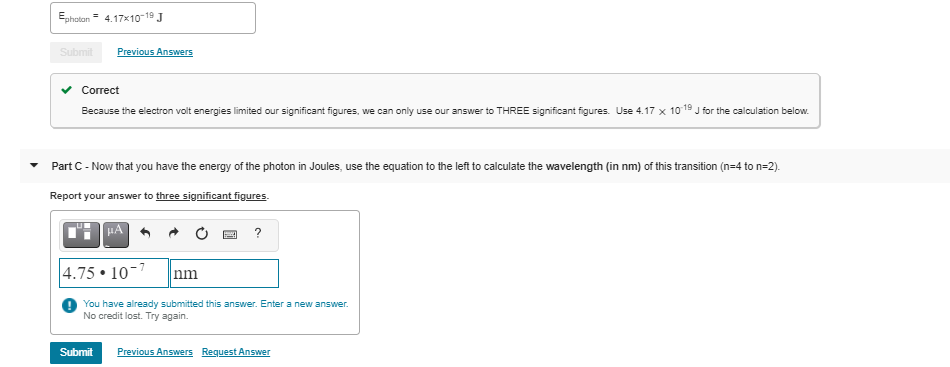Because the electron volt energies limited our significant figures, we can only use our answer to THREE significant figures. Use 4.17 x 10 J for the calculation below. Part C- Now that you have the energy of the photon in Joules, use the equation to the left to calculate the wavelength (in nm) of this transition (n=4 to n=2). Report your answer to three significant figures.
Because the electron volt energies limited our significant figures, we can only use our answer to THREE significant figures. Use 4.17 x 10 J for the calculation below. Part C- Now that you have the energy of the photon in Joules, use the equation to the left to calculate the wavelength (in nm) of this transition (n=4 to n=2). Report your answer to three significant figures.
Chemistry: An Atoms First Approach
2nd Edition
ISBN:9781305079243
Author:Steven S. Zumdahl, Susan A. Zumdahl
Publisher:Steven S. Zumdahl, Susan A. Zumdahl
Chapter2: Atomic Structure And Periodicity
Section: Chapter Questions
Problem 161CP: The figure below represents part of the emission spectrum for a one-electron ion in lhe gas phase....
Related questions
Question
The eV is 4.17x10^-19 J. It is also in the image below.

Transcribed Image Text:Ephoton = 4.17x10-19 J
Submit
Previous Answers
Сorrect
Because the electron volt energies limited our significant figures, we can only use our answer to THREE significant figures. Use 4.17 x 1019 J for the calculation below.
-
Part C- Now that you have the energy of the photon in Joules, use the equation to the left to calculate the wavelength (in nm) of this transition (n=4 to n=2).
Report your answer to three significant figures.
HA
4.75 • 10-7
nm
You have already submitted this answer. Enter a new answer.
No credit lost. Try again.
Submit
Previous Answers Request Answer
Expert Solution
This question has been solved!
Explore an expertly crafted, step-by-step solution for a thorough understanding of key concepts.
This is a popular solution!
Trending now
This is a popular solution!
Step by step
Solved in 2 steps with 2 images

Knowledge Booster
Learn more about
Need a deep-dive on the concept behind this application? Look no further. Learn more about this topic, chemistry and related others by exploring similar questions and additional content below.Recommended textbooks for you

Chemistry: An Atoms First Approach
Chemistry
ISBN:
9781305079243
Author:
Steven S. Zumdahl, Susan A. Zumdahl
Publisher:
Cengage Learning


Chemistry
Chemistry
ISBN:
9781305957404
Author:
Steven S. Zumdahl, Susan A. Zumdahl, Donald J. DeCoste
Publisher:
Cengage Learning

Chemistry: An Atoms First Approach
Chemistry
ISBN:
9781305079243
Author:
Steven S. Zumdahl, Susan A. Zumdahl
Publisher:
Cengage Learning


Chemistry
Chemistry
ISBN:
9781305957404
Author:
Steven S. Zumdahl, Susan A. Zumdahl, Donald J. DeCoste
Publisher:
Cengage Learning

Principles of Modern Chemistry
Chemistry
ISBN:
9781305079113
Author:
David W. Oxtoby, H. Pat Gillis, Laurie J. Butler
Publisher:
Cengage Learning

Chemistry for Engineering Students
Chemistry
ISBN:
9781337398909
Author:
Lawrence S. Brown, Tom Holme
Publisher:
Cengage Learning

Chemistry & Chemical Reactivity
Chemistry
ISBN:
9781133949640
Author:
John C. Kotz, Paul M. Treichel, John Townsend, David Treichel
Publisher:
Cengage Learning